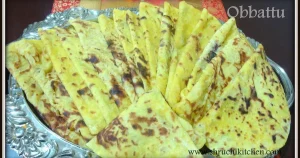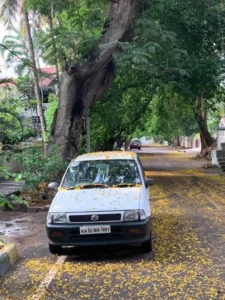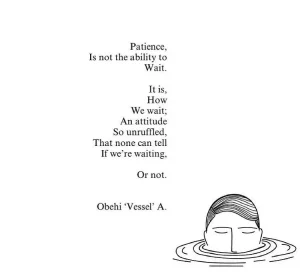
Raju and Kamala man and wife, hailed from a brahmin priest family of Dakshina Kannada (South Canara, coastal region of Karnataka). They had moved to Bangalore looking for better prospects. Bangalore had more people, and more temples, hence more ceremonies, and were seen as a multitude of opportunities.
Raju’s guru had given him a laughing Buddha -” Laugh and the world will laugh with you “. Raju believed in the concept and had even started a laughter club at the park close to his temple to beat the stress. He practiced the art of laughing every morning with the regulars. He would always carry the small Buddha as a good luck charm which got him enough business to lead a comfortable life.
After their son, Mahesha was born a favorite pastime was to sit on the ledge outside their house and dream of the younger ones’ future. Every time this conversation led to them giving up the city life and moving back to their ancestral village in Dakshina Kannada to run the family temple. After all, Dakshina Kannada was the best district when it came to results of Class X, both averages and the sheer number of rank holders. Rajus’ wanted to give their son the best possible education. It was also important to them that Mahesha learnt about the rich culture, and heritage of the land. As he grew to be 12 they started getting worried that he would fall into bad company in Bangalore. They bid goodbye to neighbors, the laughter club patrons, and temple regulars, They made the move.
Mahesha apart from helping around with work at home and the temple turned out to be a studious boy, making the Rajus’ proud. A few years later one happy morning they were all decked up to take a bus to Manipal university for Mahesha admissions. The whole trip was planned by Raju and Kamala the previous night. It would be a stopover at Udupi Sree Krishna Mutt to seek his blessings before finishing Manipal admissions. Celebrations would begin at Woodlands with Mangalore buns /Goli Baje* and end at Diana with a cutlet and a Gudbad*.
Mahesha stayed at the Manipal hostel and would make weekly visits to the village to spend time with his parents, get his clothes washed, eat home-cooked food, and meet his local friends. Rajus’ were feeling blessed with the move they made and the life they had set up around the village. Every evening they thanked God for this.
4 years later on Yugadi(Kannada new year’s day), Mahesha’s final results would be out. Kamala had woken up early to make the Bevu Bella* and also started preparations to make two kinds of Holige*. It was indeed a big day, they had dreamt of this all their lives.
Raju reached home early, finished his evening prayers picked his lucky charm and they waited for Mahesha to bring home that degree. They were filled with a sense of pride to have an engineer in the house, a first of the kind in the family.
Mahesha bowed down to God, then his parents, and gave his father the 2 documents. Raju saw the first and tears rolled down his eyes seeing the marks card. He moved slowly to the second document; a million thoughts now ran through his mind.
Why did God do this to them? What would he tell his relatives and friends back in Bangalore? Mahesha had married his classmate, Rashmi from a different caste. The laughing Buddha slipped from his hand and shattered into a thousand pieces as Rashmi walked in to seek their blessings.
Is this the real meaning of the Ugadi bevu bella?
What about you, is your laughing buddha still intact?
Bevu bella– a traditional mixture of neem and jaggery — a bittersweet reminder that the year ahead will have its share of ups and downs too
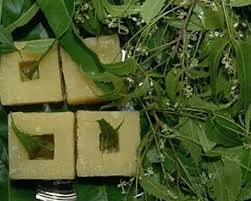
Goli baje are crisp fried fritters made with flour, curd, spices and herbs
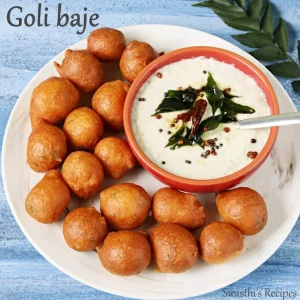
Gadbud — Gadbad is a much loved Mangalorean ice cream dessert that’s made with more than one flavor of ice cream, nuts, chopped fruits, jelly, syrup & tutti Frutti. It’s served layered in a tall glass ,
Two different stories support the birth of this delicious Gadbad Ice cream.
“Gadibadi” the slang in Kannada for mayhem, chaos or confusion led to the name “Gadbad”.Gadbad Ice cream is believed to have originated in Diana Restaurant in Udupi, Mangalore, Karnataka
One day a customer became furious when he ordered an ice cream in the restaurant & was served with meagre amount.To calm him down the cook of the restaurant dumped various left over scoops of ice cream in a bowl & dressed it up with nuts, jelly, fruits & syrup. It was brought to him as a compensation.This accidental ice cream dessert was much loved by the angry customer & thus found a permanent place in the menu of Diana restaurant.
The second story claims that the founder of the Diana restaurant Mr. Mohandas Pai accidentally invented Gadbad Ice cream.
One fine day when he ran out of several flavors of ice cream he decided to give a group of customers what he had as a left over.He scooped out the left over ice creams in a bowl & threw some nuts, fruits, jelly & syrup to make it more appealing & than served them the dessert.The customers loved it so much that they came back for that lovely invention of Mr. Mohandas Pai.
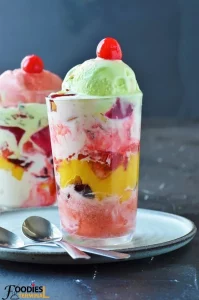
Holige – Different varieties of Indian sweet flatbread are served in Karnataka during Ugadi specifically. The most common is the one prepared with yellow gram and sugar or jaggery. Holige is also prepared using coconut and jaggery as ingredients. Also called Puran poli in Maharastra
